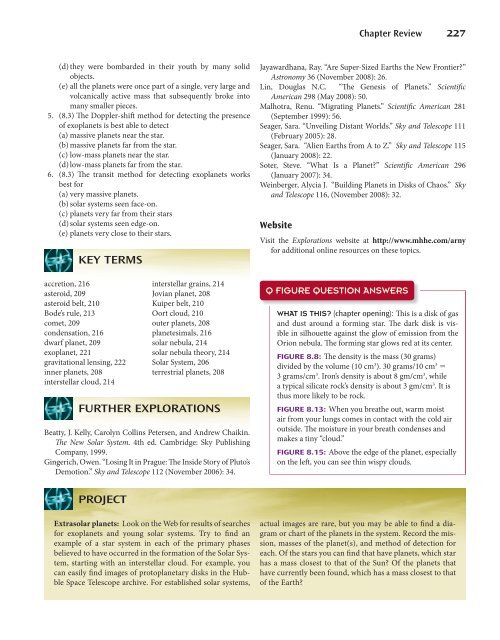Chapter 8
Chapter 8
Chapter 8
You also want an ePaper? Increase the reach of your titles
YUMPU automatically turns print PDFs into web optimized ePapers that Google loves.
(d) they were bombarded in their youth by many solid<br />
objects.<br />
(e) all the planets were once part of a single, very large and<br />
volcanically active mass that subsequently broke into<br />
many smaller pieces.<br />
5. (8.3) Th e Doppler-shift method for detecting the presence<br />
of exoplanets is best able to detect<br />
(a) massive planets near the star.<br />
(b) massive planets far from the star.<br />
(c) low-mass planets near the star.<br />
(d) low-mass planets far from the star.<br />
6. (8.3) Th e transit method for detecting exoplanets works<br />
best for<br />
(a) very massive planets.<br />
(b) solar systems seen face-on.<br />
(c) planets very far from their stars<br />
(d) solar systems seen edge-on.<br />
(e) planets very close to their stars.<br />
KEY TERMS<br />
accretion, 216<br />
asteroid, 209<br />
asteroid belt, 210<br />
Bode’s rule, 213<br />
comet, 209<br />
condensation, 216<br />
dwarf planet, 209<br />
exoplanet, 221<br />
gravitational lensing, 222<br />
inner planets, 208<br />
interstellar cloud, 214<br />
interstellar grains, 214<br />
Jovian planet, 208<br />
Kuiper belt, 210<br />
Oort cloud, 210<br />
outer planets, 208<br />
planetesimals, 216<br />
solar nebula, 214<br />
solar nebula theory, 214<br />
Solar System, 206<br />
terrestrial planets, 208<br />
FURTHER EXPLORATIONS<br />
Beatty, J. Kelly, Carolyn Collins Petersen, and Andrew Chaikin.<br />
Th e New Solar System. 4th ed. Cambridge: Sky Publishing<br />
Company, 1999.<br />
Gingerich, Owen. “Losing It in Prague: Th e Inside Story of Pluto’s<br />
Demotion.” Sky and Telescope 112 (November 2006): 34.<br />
PROJECT<br />
Extrasolar planets: Look on the Web for results of searches<br />
for exoplanets and young solar systems. Try to fi nd an<br />
example of a star system in each of the primary phases<br />
believed to have occurred in the formation of the Solar System,<br />
starting with an interstellar cloud. For example, you<br />
can easily fi nd images of protoplanetary disks in the Hubble<br />
Space Telescope archive. For established solar systems,<br />
<strong>Chapter</strong> Review 227<br />
Jayawardhana, Ray. “Are Super-Sized Earths the New Frontier?”<br />
Astronomy 36 (November 2008): 26.<br />
Lin, Douglas N.C. “Th e Genesis of Planets.” Scientifi c<br />
American 298 (May 2008): 50.<br />
Malhotra, Renu. “Migrating Planets.” Scientifi c American 281<br />
(September 1999): 56.<br />
Seager, Sara. “Unveiling Distant Worlds.” Sky and Telescope 111<br />
(February 2005): 28.<br />
Seager, Sara. “Alien Earths from A to Z.” Sky and Telescope 115<br />
(January 2008): 22.<br />
Soter, Steve. “What Is a Planet?” Scientifi c American 296<br />
(January 2007): 34.<br />
Weinberger, Alycia J. “Building Planets in Disks of Chaos.” Sky<br />
and Telescope 116, (November 2008): 32.<br />
Website<br />
Visit the Explorations website at http://www.mhhe.com/arny<br />
for additional online resources on these topics.<br />
Q FIGURE QUESTION ANSWERS<br />
WHAT IS THIS? (chapter opening): Th is is a disk of gas<br />
and dust around a forming star. Th e dark disk is visible<br />
in silhouette against the glow of emission from the<br />
Orion nebula. Th e forming star glows red at its center.<br />
FIGURE 8.8: Th e density is the mass (30 grams)<br />
divided by the volume (10 cm 3 ). 30 grams/10 cm 3 =<br />
3 grams/cm 3 . Iron’s density is about 8 gm/cm 3 , while<br />
a typical silicate rock’s density is about 3 gm/cm 3 . It is<br />
thus more likely to be rock.<br />
FIGURE 8.13: When you breathe out, warm moist<br />
air from your lungs comes in contact with the cold air<br />
outside. Th e moisture in your breath condenses and<br />
makes a tiny “cloud.”<br />
FIGURE 8.15: Above the edge of the planet, especially<br />
on the left , you can see thin wispy clouds.<br />
actual images are rare, but you may be able to fi nd a diagram<br />
or chart of the planets in the system. Record the mission,<br />
masses of the planet(s), and method of detection for<br />
each. Of the stars you can fi nd that have planets, which star<br />
has a mass closest to that of the Sun? Of the planets that<br />
have currently been found, which has a mass closest to that<br />
of the Earth?<br />
arn12176_ch08.indd 227 8/3/09 8:55:32 AM

















